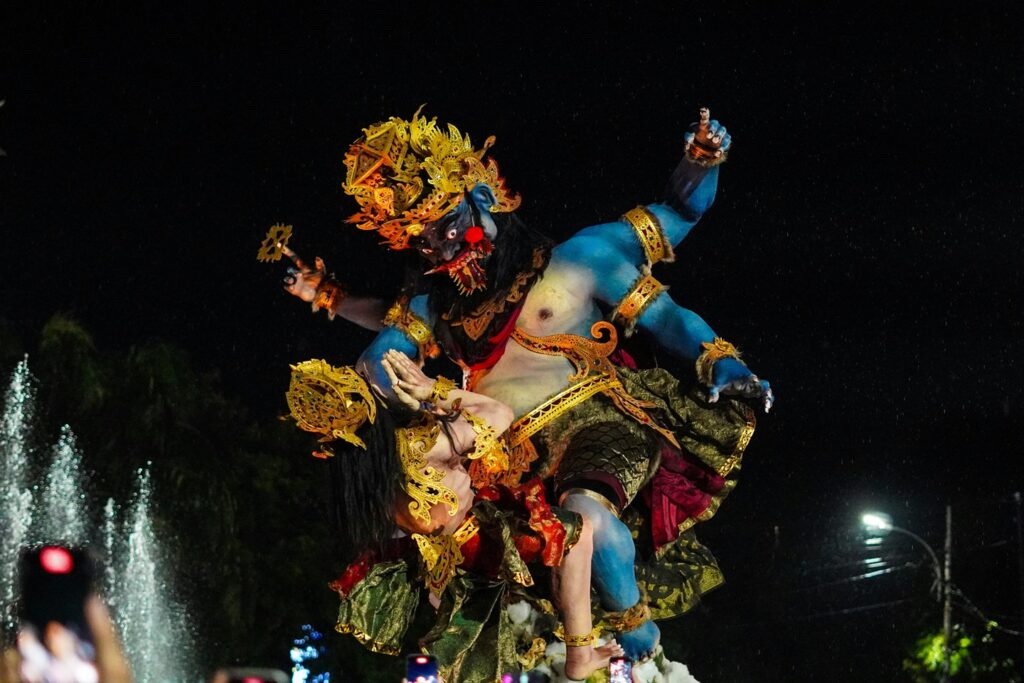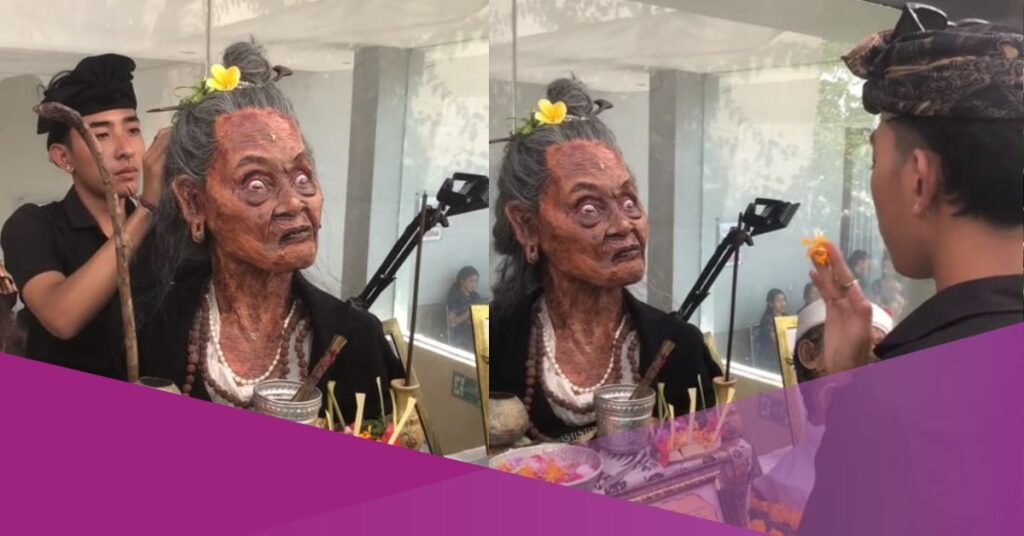For those who have visited or lived in Bali, the tradition of ogoh-ogoh is something to look forward to every year. Ogoh-ogoh are large, intricately designed sculptures that are paraded through villages on the eve of Nyepi, the Balinese Day of Silence.
These towering figures symbolize Bhuta Kala, a spiritual entity representing time and the negative forces of the universe.
Each year, Balinese communities come together to construct these impressive statues, which are then carried through the streets during Pengerupukan, the night before Nyepi.
This tradition is not only an artistic spectacle but also a deeply symbolic ritual aimed at cleansing the island of negative energy before the holy day of silence begins.
The Viral Ogoh-Ogoh That Looks Unbelievably Real
Recently, a video showcasing lifelike ogoh-ogoh has gone viral on social media. The video, uploaded by TikTok user @wiriantana022, features an ogoh-ogoh inspired by Balian Pengiwa x Dadong Guliang, a powerful spiritual figure in Balinese folklore.
The level of detail in this particular sculpture is so realistic that it has captivated audiences worldwide, with many viewers commenting on how lifelike and eerie it appears.
@wiriantana022 BALIAN PENGIWA x DADONG GULIANG🔥 #fyp #ogohogoh #ogohogohbali #tapelogohogoh #art #bali #nenek #nyepi #foryou #wiriantana #wiriantika #beranda @Wiriantika @infobalianyar @Pecinta Ogoh – Ogoh ♬ suara asli – I’am SASKARA – I’am GOPAL
Social media users flooded the comment section with reactions, with one person remarking, “The details are amazing! In my village, Dadong Guliang’s grave has existed since ancient times.“
Another netizen praised the craftsmanship, saying, “The hands of Balinese artists are truly incredible.“
Meanwhile, some viewers found the sculpture so realistic that it was unsettling, with one jokingly commenting, “This looks too real! I’m even scared to look at it on my phone screen 😂.”
The Spiritual and Cultural Significance of Ogoh-Ogoh
For the Hindu community in Bali, ogoh-ogoh are more than just artistic creations; they hold deep spiritual significance.
These statues are designed to represent the dark side of human nature and the negative energy present in the universe. After being paraded through the streets, the ogoh-ogoh are ritually burned in the Tawur Agung Kesanga ceremony. This act symbolizes the destruction of evil forces, allowing the Balinese people to start Nyepi with a purified spirit.
The creation and destruction of ogoh-ogoh serve as a metaphor for inner purification, reminding individuals to cleanse themselves of negative traits and thoughts.
The ritual also teaches the importance of living in harmony with nature and emphasizes the value of environmental conservation by discouraging behaviours that harm the ecosystem.
The History and Meaning Behind Ogoh-Ogoh
The tradition of ogoh-ogoh is deeply rooted in Balinese Hinduism. According to historical records from the Buleleng Regency Government, the term “ogoh-ogoh” originates from the Balinese word “ogah-ogah,” which means something that is shaken or moved.
This is fitting, as the statues are carried and shaken through the streets during the parade.

The purpose of ogoh-ogoh is to visually represent Bhuta Kala, reminding people of the power of time and the universe. Additionally, these sculptures serve to:
- Symbolize the forces of evil, impurity, and negativity that can influence human behaviour.
- Depict the negative traits within humans, encouraging self-reflection and self-improvement.
- Inspire people to purify their inner Bhuta Kala, or negative nature, by practising good deeds.
- Promote environmental awareness, emphasizing the need to protect nature and avoid destructive habits.
How Ogoh-Ogoh Are Made
The process of creating an ogoh-ogoh is highly intricate and requires weeks, sometimes months, of preparation.
Many Balinese communities start making their statues as early as January or February to ensure they are ready for the Pengerupukan parade.
Traditional materials such as bamboo, paper, and styrofoam are used to construct the statues, keeping them lightweight yet sturdy enough to be carried through the streets.
While ogoh-ogoh often depict mythical creatures from Mayapada (Earth), Heaven, or Naraka (Hell)—such as dragons, elephants, and celestial beings—some modern creations also feature real-life figures, including world leaders, celebrities, and religious icons.
The artistic freedom allows Balinese youth to experiment with different designs, adding their unique touch while still honouring the cultural significance of the tradition.
Ogoh-ogoh remains an essential part of Balinese Hindu traditions, bringing communities together and preserving artistic heritage.
The burning ceremony not only marks a spiritual cleansing but also unites people in a shared cultural experience. As the viral video of the Dadong Guliang ogoh-ogoh proves, this age-old tradition continues to evolve and captivate audiences worldwide, showcasing the incredible talent and dedication of Balinese artists.
With each passing year, the tradition of ogoh-ogoh grows stronger, blending ancient rituals with contemporary artistry. Whether you are a local or a visitor, witnessing this grand celebration is a once-in-a-lifetime experience that offers a profound insight into Bali’s rich spiritual and cultural heritage.


































